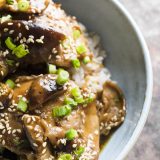Stubby plastic tables and chairs flow out of the dai pai dong that line the Temple Street Night Market in Hong Kong. These open-air food stalls are crowded with diners slurping noodles and snarfing sizzling skewers under strings of flags draped over the street. Competing neon signs advertise fish balls, bubble pancakes and, notably, clay crocks set over glowing charcoal fires.
Called wu wei, the clay pots arrive steaming with succulent marinated meat and savory rice in shops offering up to 60 combinations of toppings. Minced beef with egg. Chinese sausage with bits of salt-cured fish. Pulled chicken thighs with abalone.
One constant—the flavor profile. The meat generally is marinated in a savory blend of soy sauce, sweet rice wine and oyster or fish sauce. Rice is brought to a boil in the pot, and the marinated meat is laid on top before it’s covered and cooked over a low flame. Bits of crispy rice form on the bottom, evoking the texture of Korean bibimbap, and it’s all drizzled with dark soy sauce and sesame oil.
With so many variations, at Milk Street we needed to narrow our focus yet retain the rich, savory flavors. We drew inspiration from Australian chef Adam Liaw. In his book “Asian After Work,” he calls for marinating chicken thighs, cured sausage and shiitake mushrooms in a ginger-infused, eight-ingredient mixture before it’s cooked in a saucepan or clay pot.
Though we enjoyed the rice, we wanted our version to focus on the chicken and the savory sauce it cooks in, so we left it out. Leaving the rice as a serving suggestion also streamlined the recipe and let the flavors of the oyster sauce, soy sauce and ginger stand out clean and bright.
We began by searing bone-in, skin-on chicken thighs in a Dutch oven before removing them and discarding the skin. In a bit of the chicken fat left in the pot, we cooked shiitakes and onion, then added chicken broth and a cup of water, scraping up the flavorful browned bits. To that mixture we added the two sauces along with sliced coins of ginger, which infused flavor and contributed texture to the final dish.
The chicken was returned to the Dutch oven to cook, covered, for 40 minutes. Once the meat was cooked through, we removed it again and reduced the remaining liquid to concentrate the flavors in the sauce, which was thickened with a bit of cornstarch.
A sprinkle of sliced scallions added freshness, while toasted sesame seeds lent a subtle nuttiness. The tender chicken was coated in an aromatic sauce that suggested the bustling Hong Kong night market—minus the crowds.




